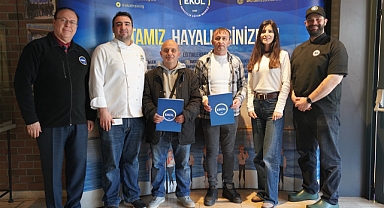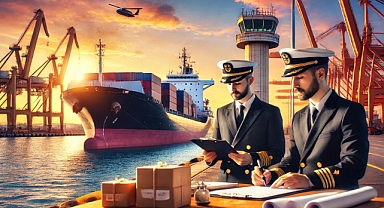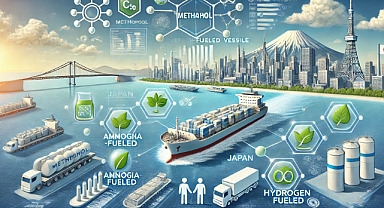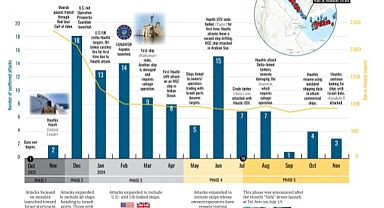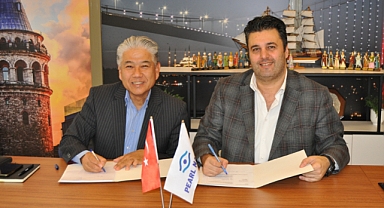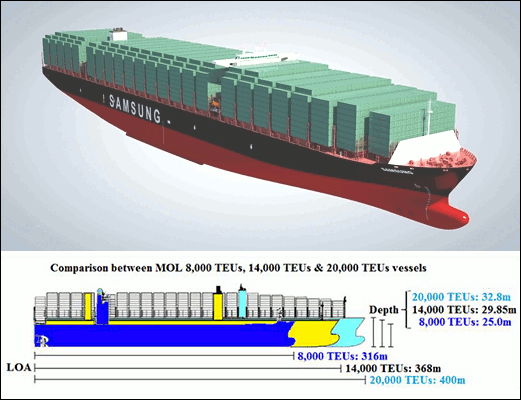As naval architects and engineers have steadily improved the operational characteristics of handymaxes over the years, ships have also increased in size, from the 45,000 dwt Handymax of the 1990’s to the 64,000 dwt Ultramax of today. During the boom years of 2004-2008, naval architects developed larger ship designs is an effort to improve the cargo carrying capacity of ships in each size sector. This permitted owners to maximize cargo intake and charterers to lower freight costs to take advantage of quickly rising Chinese commodity imports that drove freight rates to record highs. With fuel prices rising over the past decade, engineers have also been finding ways to reduce bunker consumption.
The Handymax sector has seen its share of dry bulk newbuilding (NB) orders rise to about 40% in 1H13, the highest percentage, in number of ships, since 2000. NB orders for Ultramaxes have seen a 60% yoy rise within the Handymax sector.
For this analysis when we use the term “Supramax” we mean a Chinese built Dolphin 57, “Ultramax” means a Chinese built Dolphin 64 and a “Panamax” means a Chinese built 82,000 dwt panamax with an LOA of 229 mtrs. “Handymax” refers to geared ships of 45,000-64,000 dwt with an LOA not exceeding 200mtrs.
Prior to making a significant investment in a new Ultramax, one really needs to analyze the Ultramax design from the perspective of international trade as well as intra-Asian trading and shipping … the business for which they were mainly designed. Because they all compete for many of the same cargoes, this cost/benefit analysis will compare the delivered cost of freight between a Supramax, the new Ultramax and a Panamax. The advantages and disadvantages of each vessel type will be reviewed and analyzed. For a fair comparison, all three ship types are assumed to have been built in China Cargo comparisons will include coal, grain and ores as well as shallow and deep draft ports. Voyages will compare the advantages and disadvantages of dwt/draft ratio, total cargo carrying capacity, grain cubics and speed & consumption. Long haul and short haul voyages will be compared to analyze sea steaming performance. An investment analysis will be made on the newbuilding purchase (or period timecharter) of these 3 ship types and the expected ROI based on our expectations of vessel earnings 5-8 years after delivery from the shipyard.
The Ultramax is basically a Supramax with a 10 meter longer LOA. With today’s high fuel prices and increasingly stringent pollution regulations, designers are paying far more attention to improving fuel efficiency … and the Ultramax is the latest culmination of these design efforts. There are presently about 100 Ultramaxes trading and another 150 NB’s on order with delivery by end 2014. Ultramax NB orders are expected to increase significantly as their popularity increases.
Interestingly, the Ultramax is now the same size as the older, obsolete 64,000 dwt panamaxes that nobody wants today!!! And actually are not that much more fuel efficient than a 1984 built Japanese 64,000 dwt panamax that could do 14 knots laden on 30-32mt ifo + 2.5 mt mdo … the difference being in the better cubic’s of the Ultramax, lower total fuel consumption on a shorter LOA and the addition of cranes.
Fuel savings has been obtained from a better hull form, propeller design and the use of an electronically controlled main engine. In order to reduce fuel consumption, the main engine has less horsepower than a Supramax and is designed to run at a lower RPM (reducing maintenance on moving parts). The ship will meet the latest pollution and environmental regulations that will come into force over the next few years. The only drawback to these main engines will be a ship with a slower maximum speed during strong markets. The low horsepower will limit the maximum fully laden speed to about 14 knots in good weather (assuming a clean bottom), versus 14.5-15.0 knots attainable on a Supramax, should the captain want to “hook her up”.
We are using China and India as the main discharge areas as they are the driver of import growth for Ultramax ships (and bulk trades) and because these ships have really been designed for intra-Asian trading where the ships gear and grabs are required at many load and/or discharge ports. We will also use some other loading and discharging ports where these ships will also be competing to transport non intra-Asian cargoes and other trades where there are draft restrictions. We will also compare the Ultramax to the Supramax on voyages where there is a maximum cargo size restriction of 55,000mt (50,000mt 10% moloo) which is quite normal on many trades as will be explained later.
The vessels to be compared are described as follows:
Vessel DWT Draft LOA Beam Grain Cubics Speed Consumption Speed Consumption
Type (mt) (mtrs) (mtrs) (mtrs) (cumtrs) Laden Laden *** Ballast Ballast
DOLPHIN 57 57,081 12.80 190 32.2 71,500 14.0 34 + 0.2 ** 14.5 33 + 0.2
DOLPHIN 64 63,800 13.30 200 32.2 77,500 14.0 30 14.5 29
PANAMAX 82 81,882 14.50 229 32.2 98,610 14.0 36 + 0.2 14.5 34.5 + 0.2
** MDO consumption/day
*** Consumptions and drafts are at SSW draft
Dolphin 57 12700 HP @ MCR Normal operation @ 80-85% MCR
Dolphin 64 10940 HP @ MCR for all ships
Panamax 82 13500 HP @ MCR
The low HP of the Dolphin 64 makes us wonder about the ability to maintain 14 knots fully laden in wind
conditions of BF-4 and sea condtions of DSS-3
Vessel Freight and Earnings Comparison
This analysis will be based on ships built in China because about 70% of Supramax and Ultramax newbuilding orders this year have been placed with Chinese shipyards. Freight studies were completed using our in house custom designed freight estimating program. The results are on the appended “Vessel Comparison” spread sheets.
Comments from the Vessel Comparison spreadsheet:
For SE Asian cargoes, Ultramaxes can compete better with Panamaxes when there is sufficient cargo available from the supplier, logistically, because the additional cost of floating cranes is not required. The Supramax … balance for subscribers.
On the 10 different voyages that we analyzed, Ultramax earnings averaged (subscribers only) more than the Supramax. These were a combination of long and short haul voyages loading coal, grain and ore with discharge at ports having a draft restriction and no draft restriction.
Due to excellent fuel efficiency, earnings on an Ultramax … for subscribers only.
The Ultramax offers a better all around investment for charterers and shipowners due to its higher cargo carrying capacity and better fuel efficiency (partially gained from derated engine with less HP) as compared to the Supramax. The Panama Canal upgrade will be completed in late 2015 permitting capesize laden transits at 15.2 meters draft. We are not yet sure how this will impact on Panamax cargo volumes, but we suspect it will reduce available Panamax cargoes as they start competing directly with capesize ships on some front haul trades. Routing of capesize coal cargoes ex-USEC and coal/grain cargoes ex-Miss River to Asia via the Panama Canal should change some trading patterns. USEC coal should start in 2015 and Miss River coal/grain in 2017-18, as the draft of the Mississippi River is dredged, in stages, to 50 feet.
Cost Analysis and Return on Investment (IRR)
A cost analysis will be made on the purchase of each of these 3 ship sizes with expected ROI (using IRR method of discounted cash flow analysis) based on our expectations of freight market levels over the next 10 years. Interest rates are assumed to be rising over the life of the investment analysis, mainly due to high government debt loads and the perceived risk of holding the debt of governments with high debt/GDP ratios. Investors will want higher interest rates to hold government debt when “free money” is competing for other more attractive and less risky investment alternatives. The rise in the interest rates on government debt, the basis for which longer term debt financing is based, will lead to higher interest rates on traditional ship mortgages and bond issuances. With banks reducing their exposure to ship financing over the past few years, we assume that ship mortgage interest rates will be 5% for the first 2 years and rise to 7% thereafter. With a few clicks on the appended “Investment Analysis” Excel spread sheets, the earnings projections, interest rates and assumed operating costs can be changed.
Historically, Japanese yards have built the largest number of handymax ships, with about 45% of the current fleet, numerically, having been built in Japan. However, with the proliferation of new Chinese shipyards, their share of handymax orders rose to about 70% in 1H13. Design innovation has typically come from Japanese yards, but with the SDARI Supramax 57 and new Ultramax 64 designs, Chinese yards are now building the largest Handymaxes available from any yard, worldwide. In 2010, only 2-3 yards were offering Ultramax designs, but this has increased to 15 yards which booked about 80 Ultramax NB orders in 1H13. Japanese Ultramax designs average about 2,500mt dwt less than the average Chinese Crown or Dolphin Ultramax NB’s, with the Dolphin 64 of 63,800mt deadweight presently being the largest and most popular design.
Chinese NB Prices at mid-September (for Japanese built ships add about US$2.0-2.5 million) are set out below. These prices include better equipment than the standard “cookie cutter” specifications and are based on delivery in late 2015 with a 40/60 payment plan:
Dolphin 57 US$ 27.0 million
Dolphin 64 27.5
Panamax 82 29.0
Our interest rate of 5% for the first 2 years of the loan is taken by averaging the interest rate on a syndicated bank mortgage which is typically based on 6 month US$ LIBOR (0.4%) + 3.5% and the 3-4 year bond interest rate of about 6% available for a well rated shipowner that can issue bonds.
Comments from the Investment Analysis:
Interestingly, FFA’s (options price used where FFA’s not available) for a Supramax and Panamax are now priced at about US$10,250/11,000 for calendar 2105, US$10,350/11,400 for 2016 and US$10,600/11,400 for 2017. We are more optimistic than this and our next Shipping Market Assessment (SMA) will show our reasoning for this more positive sentiment.
Cargo & Operational Considerations
The Ultramax vessel can be a better choice for coal shippers and traders versus the Supramax due to its ability to load a larger cargo while not encumbering the shipper with the added expense of hiring a floating crane. A floating crane can cost US$1.00-2.00/mt, depending on the shippers annually contracted throughput. However, not all shippers can provide 60,000-63,000mt of coal or ores on a single cargo shipment due to mining limitations, inland logistics and/or availability of trans-shipment barges. These issues will continue to affect the availability of having sufficient cargo for a single large shipment and hence the reason why ships of 45,000-58,000 dwt will remain in demand for many years to come.
Presently, 50,000mt 10% (sometimes 55,000mt 10% is available) is the preferred cargo size for a large number of SE Asian exporters, including Indonesian shippers of coal, iron ore and nickel ore. It used to be that 45,000mt 10% was the preferred cargo size for shippers, but with the advent of the 52-57,000 dwt supramax, cargo stem sizes have slowly increased over the last 10 years. Many mines only produce 1,000-1,500mt/day of coal or ore. Although many shippers agree to sell 50,000mt 10% moloo - with a maximum of 55,000mt - there are still a large number of deadfreight disputes between shippers and shipowners because the shipper failed to provide the maximum cargo of 55,000mt required under CP terms. There continue to be major disputes over loading port demurrage simply because the shippers can not supply and load the cargo within the agreed laytime allowance - mainly due to problems with cargo logistics ashore.
Many shippers that can easily load 61-62,000mt on an Ultramax still prefer to load a gearless panamax with 79-82000mt of cargo using floating cranes to take advantage of the much lower freight offered by panamaxes. The Ultramax can compete with this issue, if the owners provide a reasonable freight level that takes into account the cost of floating cranes needed for loading a panamax.
There are, however, cargo receivers that prefer panamax cargoes to reduce the number shipments and to ease logistics problems at the disport. The number of floating cranes in Indonesian waters is increasing every year and they are getting more sophisticated, offering loading speeds upto 25,000mt/day.
While a Supramax or Ultramax may be able to physically load at 15,000 mt/day using their own cranes and grabs, the barges are generally not available in sufficient quantities to permit such loading speeds, and much of the laytime is used up waiting for barges to bring cargo alongside the ship.
Many disports in India and Thailand, where a significant portion of Australian and Indonesian coal is destined, have upgraded port infrastructure in recent years. Rather than discharging offshore, new coastal power and steel plants have built discharge berths with deep drafts and shore based cranes for cargo discharge. This speeds up cargo discharge without the aggravation of discharging first into barges and then again from barges onto land (double handling).
Shippers that can provide a full cargo for an Ultramax is slowly growing. There will be 1200 Supramaxes trading by late 2014. There will be about 250 Ultramax bulkers trading by late 2014, or about 17% of the total Supra/Ultramax fleet. For many cargo buyers, it is easier to obtain letters of credit for 50,000-60,000mt cargoes than for a panamax cargo of 80,000mt. Thus, using an Ultramax may increase a shipper’s profit more than shipping a panamax cargo, provided the Ultramax passes on some of the savings it can achieve over a Supramax. With only about 100 Ultramaxes currently trading, many owners of these ships have been pricing themselves out of the market by asking for rates (on T/C) that make them “psychologically” unattractive to many charterers. While these comparatively high T/C rates exist, many shippers that can provide full cargoes of 60,000-85,000mt are preferring to charter a panamax and use floating cranes for loading due to the cheaper freight alternative. Theoretically, an Ultramax can save a shipper US$1.50-1.75/mt versus using a Supramax on a typical Indonesian coal cargo to China or India. We expect the Ultramax owner will split this cost savings with the shipper as the Ultramax fleet grows and competition between owners increases. Eventually we expect that a freight rate differential between Surpamaxes and Ultramaxes will develop whereby the Ultramax freight savings is passed on almost entirely to the shipper. This will mean the Ultramax still earns more than a Supramax, but not to the same extent as is presently the case. This is just a natural evolution of supply and demand as shippers/buyers gravitate to the cheapest freight alternative that also provides the least risk.
Ultramaxes are ideal for Asian trade. With an LOA of 199 meters, the Ultramax is still smaller than a Panamax and slightly larger than a Supramax, and it provides its own cranes and grabs. All ports that can handle panamax vessels can easily handle an Ultramax. Likewise, most ports that can handle a Supramax can also handle an Ultramax. Even with a large volume of cargo traded within Asia that loads and/or discharges at offshore trans-shipment anchorages in countries such as Bangladesh, India, Indonesia, Philippines, Singapore and Vietnam, there is rarely a draft restriction at the loading port and the only issue is whether the disport has a draft restriction. Even with a disport draft restriction, the Ultramax can still load 3,000-3,500mt more cargo than a Supramax. Provided the shipper can supply the additional quantity or the buyer actually wants it, the Ultramax has 6,500-6,750mt more cargo carrying capacity than a Supramax on full draft.
Loading issues in SE Asia, and especially in Indonesia:
Ultramaxes, like their Handymax and Supramax cousins, have been designed mainly for self loading cargoes from barges at offshore trans-shipment anchorages, mainly coal, iron ore and nickel ore and for self-discharging, if required. Such trades are mainly shorter haul intra-Asian voyages.
1. After the ship arrives at the loading anchorage, delays can be upto 30 days before loading actually begins. Such delays are mainly due to rain, mining problems, cargo quality issues, various trucking problems delivering the cargo from the mine to the barge loading jetty, and obtaining a sufficient number of barges – of the proper size - that are required for loading bigger ships.
2. Getting cargo stems increased from the usual 45,000mt 10% several years ago to the normal size of 50,000mt 10% today has been made through extraordinary efforts made by cargo suppliers and traders. Providing cargo stem sizes of 50,000mt 10% for a single shipment remains a monumental task for many miners and shippers. Many times shippers must “parcel” cargoes together from various small mines just to provide a full cargo of 55,000mt (on a 50,000 10% cargo) in the hope of not occurring dead freight and loading demurrage. The problem with parceling is that each mine owner has their own opinion of the price of the commodity, and therefore getting all the parcels together with the proper specification from the various miners required to provide a full cargo stem means that the trader must get all suppliers to agree on a price acceptable to the buyer and also get the cargo to the barge loading facilities at the same time while also assuring that the quality of all the cargo parcels meet the terms of sales contract. During the rainy season this task is compounded by logistical issues.
Conclusion:
Roads and infrastructure between the mines and loading ports (many are just barge loading jetties) throughout SE Asia must improve. The same holds true for getting imported cargoes out of discharge ports and to the end user in developing countries. Until this happens, and exports continue growing, the need for Handymax ships will grow. We don’t envisage many major Indonesian coal or ore loading ports will be built over the next 10 years as they continue to use the tried and proven method of trucking cargo to a barge loading jetty and then barging the cargo out to a geared vessel at an anchorage. However, importing countries such as India, the Philippines, Thailand and Vietnam are expected to build new ports over the next 10 years to accept larger vessels, including capesize. This will permit them to import larger shipments of cargo, mainly thermal coal, at lower freight costs. Capesize shipments are expected to increase, especially to India and Thailand. Within Indonesia, over time, the roads and infrastructure will improve but it is not an easy task if one knows the “Indonesian system”. There is a major need for new and wider roads, bridges, barge jetties, cargo storage areas and less pilfering of cargo. Improvements to infrastructure will be slow in coming, but it will come.
Many new and faster floating cranes are being setup at popular offshore Indonesian loading areas and barges are being built to accompany these cranes, thus permitting a dedicated full service operation. Loading speeds on panamax and capesize cargoes will increase, lowering freight costs.
Even with the natural gravitation towards larger ships and cargoes, there is definitely room for the “handymax” of 52,000-57,000 dwt for many more years to come.
More new coal and ore (iron and nickel) mines will start production over the years. New mines are still spread out all over Indonesia and the Philippines, making the use of centralized loading ports and distribution centers difficult for most mining companies – hence loading offshore from barges is here to stay for a long time to come. For many mining companies, this is still a cheaper option than building a proper loading port.
Many charterers try to timecharter an Ultramax at close to the same rate as a Supramax. For maximum earnings, the Ultramax should be traded on a voyage charter basis in order for owners to maximize the ships’ earnings potential.
With the increased beam (49 mtrs) and draft (15.2 mtrs) of the Panama Canal, the Panamax will loose its “panama maximum” status, and will start to compete directly with small capes and full capes (on reduced draft) that will be routed via the Panama Canal starting in 2015. The Panamax will continue to be the “work horse” for shipping coal and grain for many years to come, but it is difficult to analyze the effects of a deeper Panama Canal at this stage because cargo buyers ultimately determine the size of cargo shipments.
The Ultramax is the way to go as Handymax cargo sizes slowly become larger and shippers/receivers continually look for cheaper freight alternatives. This will see the Supramax becoming less desirable and the Ultramax competes directly for Supramax cargoes as well as Panamax cargoes.







